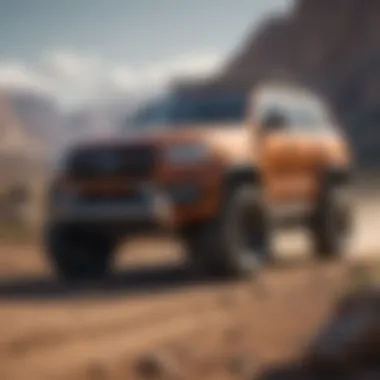Exploring the Largest SUVs on the Market Today


Intro
In a world where road presence often speaks louder than words, larger SUVs have carved out a niche that combines luxury, utility, and power. These leviathans of the automotive realm are not just about size; they represent a lifestyle choice for many consumers. As the market evolves, so too do the demands and preferences of buyers, influencing the designs and features automotive brands incorporate into their largest utility vehicles.
Understanding the dynamics behind purchasing decisions in this segment can shine a light on why certain models rise to prominence while others dwindle into obscurity, even as new vehicles regularly hit the showroom floor. This article explores the current landscape of the largest SUVs, examining their attributes, specifications, and what makes them appealing within a competitive marketplace.
Vehicle Purchasing Behavior
Factors Influencing Vehicle Purchases
When shoppers set out to buy a vehicle, several factors come into play, especially for larger SUVs. Size, for instance, is a fundamental consideration. Buyers often seek the spacious interiors these vehicles offer for family outings or transporting cargo. Yet, the allure doesn't stop there. Style and brand reputation heavily weigh on decisions. Many consumers gravitate towards brands that have established a long-standing trust among drivers, such as Chevrolet or Ford. Other factors include:
- Fuel efficiency: Rising fuel costs mean these buyers are increasingly mindful of how often they’ll need to fill up.
- Safety ratings: Families target SUVs with top-tier safety scores, as these vehicles offer both space and security.
- Technological features: Connectivity and infotainment systems enhance the driving experience, especially with younger consumers.
These aspects converge to create a unique buyer’s journey, shaping the market in ways that brands must continuously adapt to in order to stay relevant.
Demographics of Buyers
Digging a bit deeper, it becomes apparent that the demographics of SUV buyers are as diverse as the models themselves. While families often form the backbone of this market segment, single professionals and older couples are also frequent purchasers, motivated by different sets of criteria. For families, the spaciousness and safety features are typically paramount; for singles or couples, the focus may shift to style and tech capabilities.
Notably:
- Families: Often in search of reliable and safe options to accommodate children and their gear.
- Professionals: Who may opt for mid-size SUVs that balance corporate image with practicality.
- Retirees: Looking for comfortable vehicles that facilitate road trips and leisure activities.
Thus, understanding these different motivations is key for manufacturers aiming to cater to a broad audience.
Market Insights and Analysis
Consumer Behavior Analysis
As the automotive landscape shifts towards sustainability, consumers are increasingly curious about the environmental impact of their vehicles. Fuel economy has become a hot topic; larger SUVs are responding with hybrid and electric options. This is not just a trend—it's reshaping the way buyers evaluate performance. In recent surveys, many consumers expressed a desire for technology features that enhance convenience, such as advanced navigation systems and smartphone integration capabilities, illustrating a growing intersection between practicality and tech-savvy needs.
"Today's buyers want their vehicles to be more than just transportation; they seek an integrated experience that merges technology and comfort."
Competitor Analysis
The competition in the SUV market is fierce. Brands must differentiate themselves not just by features, but also by emphasizing unique selling propositions. Manufacturers like Toyota and Nissan have established strong followings with their rugged durability and reliability. Meanwhile, brands like Tesla have entered the large SUV segment, pushing boundaries with electric models that prioritize sustainability alongside luxury and performance.
As buyers scour the options available, they are not just looking for the biggest vehicle. They evaluate all attributes collectively—size, specs, fuel consumption, and brand reputation story. It's this combination that ultimately determines which models gain traction.
Understanding Large SUVs
In today's automotive landscape, large SUVs hold a significant position, appealing to a diverse group of consumers. The importance of understanding large SUVs extends beyond mere specifications and dimensions. It's about grasping the essence of what these vehicles represent in terms of lifestyle, versatility, and evolving market dynamics. For families, adventurers, or even city dwellers, these towering machines offer a blend of space, performance, and capability that smaller vehicles often lack.
Recognizing the nuances of size in SUVs is crucial, especially when it comes to making informed purchasing decisions. Larger SUVs frequently cater to specific needs, such as towing capabilities for boats or trailers, providing ample interior room for passengers and cargo, and offering advanced safety features. This article aims to break down these elements in a way that resonates with automotive enthusiasts and potential buyers alike.
Defining Size in SUVs
To appreciate what makes a large SUV, one must first understand how size is defined within this category. Generally, any SUV that measures above 170 inches in overall length can be classified as large. However, this categorization can vary slightly by manufacturer and model. The key takeaway here is that size is not just about the number on the tape measure; it has direct implications for functionality.
Large SUVs typically feature an extended wheelbase and wider girth, which translate into several advantages:
- Increased interior space: More legroom and headroom for passengers.
- Enhanced cargo capacity: room for larger luggage, sports equipment, or groceries.
- Driving stability: A heftier frame often leads to better handling and road grip.
While a larger SUV may be pricier upfront, many find themselves justifying the extra cost due to the added benefits that come with the territory.
Market Trends in Large SUVs
The market for large SUVs has evolved dramatically in recent years. As consumer preferences shift, several notable trends have emerged:
- Growing popularity of crossovers: Consumers are increasingly leaning towards models that blend the robustness of SUVs with the maneuverability of cars, resulting in a wider range of offerings.
- Focus on fuel efficiency: Manufacturers are adapting to pressures around fuel consumption, introducing hybrid and electric models, making larger SUVs more appealing for the environmentally conscious.
- Technological advancements: Today's large SUVs are equipped with cutting-edge technology—from advanced infotainment systems to enhanced safety and driver-assistance features.
It’s clear that the large SUV segment is not standing still. Rather, it’s adapting to meet demands while pushing the envelope on performance and sustainability. As buyers take a more analytical approach to their purchases, understanding these trends will play a pivotal role in navigating the choices available in this competitive market.
"The automotive world is shifting; understanding trends in large SUVs is not just beneficial, it's essential for those seeking to make an informed choice."
By understanding the foundational elements of large SUVs—size definitions and market trends—consumers can better navigate their options and select a model that aligns with their lifestyle and values. This intricate dance between size, function, and market dynamics shapes the landscape of large SUVs today.
Key Players in the Large SUV Market


Understanding the landscape of large SUVs isn't just about their physical dimensions or the amount of chrome emblazoned on their hoods. The key players in this market represent a critical intersection of consumer preferences, branding muscle, and engineering prowess. Each brand carries its own reputation and set of expectations, and their offerings reveal much about what buyers are really looking for when they opt for a larger vehicle. Understanding these dynamics can provide deeper insights for potential buyers and automotive enthusiasts alike.
American Brands Leading the Charge
American manufacturers have traditionally dominated the large SUV scene, leaning heavily on nostalgia and a rugged image that appeals to a broad audience. Brands like Ford, with its Expedition, and Chevrolet, featuring the Tahoe and Suburban, showcase a blend of size, power, and utility that resonates well with families and adventurers.
American SUVs often emphasize towing capacities, off-road capabilities, and spacious interiors. The styling is muscular, giving buyers the impression they’re driving something tough and reliable. Larger-than-life models can be seen cruising down highways, often filled with kids and gear for weekend getaways or outdoor excursions.
One can argue that the appeal of these American models is not just in their specifications but also in the stories behind them. For example, many of these vehicles have been around long enough to develop a loyal following, creating a narrative in which owning one becomes more than just a practical decision; it’s about belonging to a community that values freedom and adventure.
European Luxury Giants
When luxury meets size, European brands step onto the battlefield with a suave elegance that’s hard to resist. Audi, BMW, and Mercedes-Benz lead the charge with their full-sized options like the Q7, X7, and GLS, respectively. These vehicles don’t just focus on space; they also add a layer of sophistication that appeals to discerning buyers willing to pay a premium.
The driving experience in these European giants often feels like a well-orchestrated symphony of performance and comfort. They come packed with advanced technologies and features that enhance both driving pleasure and passenger experience. Take the Mercedes-Benz GLS as an example: Its luxurious interior, complete with premium materials and smart infotainment, makes long road trips feel indulgent rather than exhausting.
Moreover, these SUVs typically boast superior handling and a range of powerful engine options, proving that size does not have to compromise agility. The modern consumer craves not only space but also the status and prestige that comes with owning a high-end vehicle from Europe.
Emerging Competitors from Asia
Asian brands are making notable strides in the large SUV market, with manufacturers such as Toyota, Nissan, and Hyundai setting new benchmarks in terms of affordability, reliability, and innovative features. The Toyota Sequoia and Hyundai Palisade, for instance, illustrate this trend quite well by providing ample space and comfort without breaking the bank.
One interesting angle to highlight is how these manufacturers are tailoring their offerings to suit a changing marketplace. For example, they are increasingly focusing on fuel efficiency and hybrid options, responding to environmental concerns and rising fuel costs. This proactive approach resonates particularly well with today’s more environmentally conscious consumers.
Moreover, the price point of these models often stands out compared to their American and European counterparts. Buyers looking for a large SUV that doesn’t skimp on features without the luxury price tag can find compelling choices in this segment.
- The large SUV market is dynamically evolving, with key players adapting to consumer needs, technological advancements, and shifting market trends.
Dimensions and Capacities of Notable Models
When diving into the world of large SUVs, dimensions and capacities are paramount. These factors not only define the overall footprint of the vehicles but also influence their usability and appeal to buyers. In a market crowded with options, understanding the size specifications— from length and width to how much space is available for passengers and cargo— can help consumers make informed decisions. Today’s consumers demand spacious interiors, adaptable cargo capacities, and versatile layouts, making these attributes central to any SUV's market presence.
Measuring Length and Width
When it comes to large SUVs, length and width can make or break a driving experience. The average large SUV usually measures between 190 to 220 inches in length. A vehicle like the Chevrolet Tahoe, for example, comes in right around 210 inches. This extra length translates into more legroom for passengers and spacious cargo areas. However, maneuvering a longer vehicle can be less straightforward, especially in tight urban spots.
- A wider body can enhance stability during high-speed maneuvers or in adverse weather— a crucial consideration for many buyers.
- Typically, large SUVs boast a width of 75 to 80 inches. For instance, the Ford Expedition is about 79 inches wide, making it feel spacious from the inside, and more manageable when parked.
- Companies often provide this data, but potential buyers should always check personal preferences—after all, knowing how the vehicle fits into your life can be the difference between love and regret.
Seating and Cargo Capacities
One of the glaring benefits of opting for a large SUV is the ability to accommodate both passengers and luggage without breaking a sweat. Many models offer seating for up to eight occupants. The Honda Pilot, for example, has a three-row seating arrangement, allowing families or large groups to travel comfortably together.
On the flip side, the versatility of seating can often dictate cargo space. Foldable seats are a common feature across most large SUVs, which can expand cargo room dramatically. The Toyota Sequoia, when the back seats are down, boasts a cargo volume of about 120 cubic feet, which is nearly enough to transport a small mountain of gear.
In summary, understanding seating and cargo capacities is equally important. What’s the point of a spacious vehicle if it can’t hold your family's bags for a weekend trip or your mountain bike for that climbing adventure? Here is a quick comparison:
- Chevrolet Tahoe: 7-9 passengers, 122.9 cubic feet of cargo space (with seats down).
- Hyundai Palisade: 7-8 passengers, 86.4 cubic feet with third-row seats folded.
- Subaru Ascent: 7-8 passengers, 86.5 cubic feet when rear seats are folded.
"Dimensions are not just numbers on paper; they are pivotal in determining how usable an SUV truly is for its owner."
Understanding dimensions and seating arrangements can greatly influence not just comfort but the overall experience of owning a large SUV. It's the type of knowledge that separates a pedestrian purchase from a truly satisfying ownership experience.
Performance Metrics
In the realm of large SUVs, splashing into the world of performance metrics reveals more than just numbers; it’s a glimpse into what truly drives these behemoths. With their notable size and heft, performance can make or break the appeal of such vehicles. Potential buyers seek robust performance metrics—namely engine power, torque, and fuel efficiency—giving them clarity on how these SUVs stand up to their expectations, whether it’s for a thrilling ride or everyday practicality.
Engine Power and Torque
Engine power and torque are the bread and butter of any vehicle's performance. For large SUVs, these components are crucial because they define how well the vehicle can handle various situations, particularly towing or off-roading. When one taps the gas, having a powerful engine means quicker acceleration, which is essential for merging onto highways or overtaking slower traffic.
Torque, on the other hand, represents the force that moves the SUV. A high torque output is especially beneficial for those who might want to tow boats or campers, as it provides the necessary grunt when starting from a standstill, or taking on steep grades.
Consider the Ford Expedition, known for its potent engine options, which boast impressive torque numbers. This means not only can it accommodate a large family with ease, but it can also haul considerable cargo without breaking a sweat. Alternatively, the Chevrolet Tahoe combines significant power with a smooth ride experience, allowing for comfortable travels regardless of how full the car is.
Some notable metrics include:
- Horsepower: Indicates potential power available at high RPM.
- Torque: Essential for towing and off-road capabilities.
- Acceleration: How fast can the SUV reach 60 mph?
These factors become paramount when assessing any large SUV’s usability in real-world conditions.
Fuel Efficiency Comparisons


Fuel economy in large SUVs is a double-edged sword. While many consumers crave the brawn that these vehicles offer, they also seek to minimize the strain on their wallets at the fuel pump. As large SUVs are traditionally known for thirsting after gasoline, recent advancements have led to more fuel-efficient options than ever before.
Interestingly, hybrid systems are making waves. The Toyota Highlander Hybrid, for instance, offers a remarkable fusion of power and efficiency, attracting those who might fear the mounting fuel costs associated with traditional large SUVs. Another example is the Kia Telluride, which despite being a larger SUV, has managed to strike a balance between decent fuel efficiency and keeping the enjoyment of driving alive.
When comparing fuel efficiency, consider these metrics:
- Miles per Gallon (MPG): A straightforward measure of how far a vehicle can go on a gallon of fuel.
- City vs. Highway MPG: Important for assessing typical usage scenarios.
- Eco-driving indicators: Features that can assist drivers in maximizing efficiency.
Ultimately, understanding how these performance metrics coincide assists buyers in making informed choices when choosing their dream SUV.
Safety Features and Ratings
In the context of large SUVs, safety features and ratings are paramount for both manufacturers and consumers alike. Given the size and weight of these vehicles, which can tip the scales at over 6,000 pounds, ensuring they are equipped to handle potential risks is not just a regulatory obligation but a critical expectation from buyers. Modern buyers are increasingly prioritizing safety over flashy designs or even performance metrics. As such, understanding what safety features are standard in these behemoths, and how they perform in standardized tests can significantly affect purchasing decisions.
With the rise in road safety awareness and stricter regulations, manufacturers are now incorporating numerous safety technologies into their SUVs. It’s not just about how well a vehicle can withstand an impact, but also how well it can prevent accidents from happening in the first place. This section seeks to elucidate those features and dive deep into crash test performances.
Standard Safety Equipment
When it comes to standard safety equipment, large SUVs are typically equipped with a plethora of features designed to protect passengers in case of an accident. Some commonly included safety features are:
- Airbags: Most large SUVs come fitted with multiple airbags, including front, side, and curtain airbags, to cushion occupants during a collision.
- Anti-lock Braking Systems (ABS): This feature helps prevent wheel lock-up during hard braking, thereby improving vehicle control and decreasing stopping distances in emergencies.
- Electronic Stability Control (ESC): This technology helps drivers maintain control by detecting and reducing loss of traction during extreme steering maneuvers.
- Blind Spot Monitoring: This system uses sensors to observe the rear side of the vehicle, alerting drivers to the presence of other vehicles in their blind spots.
- Lane Departure Warning (LDW): A crucial feature that alerts drivers when they unintentionally drift out of their lane without signaling.
These features not only enhance the overall safety of large SUVs but also instill greater confidence for consumers who may be transporting their families on long journeys.
Crash Test Performance
Crash test performance is another critical component in assessing the safety of large SUVs. Organizations like the National Highway Traffic Safety Administration (NHTSA) and the Insurance Institute for Highway Safety (IIHS) conduct rigorous crash tests to rate vehicle safety. Each SUV undergoes various tests, including front, side, and rollover tests, to gauge how it fares in real collisions.
"The safety of large SUVs isn’t just in how they survive crashes; it’s how they provide the peace of mind that comes with smart engineering."
- Five-Star Ratings: For many consumers, a five-star safety rating from the NHTSA is a key buying factor. Models that score high tend to see increased sales as buyers associate higher ratings with better protection.
- Top Safety Pick Status: The IIHS categorizes vehicles as Top Safety Picks based on their performance in tests and the availability of advanced safety features, making it easier for consumers to identify the safest choices.
It's essential for potential buyers to not only rely on the manufacturer's claim of safety but also to scrutinize the independent ratings to verify how the SUV stands up against its competitors.
Technology Offerings
When it comes to large SUVs, technology offerings often serve as a linchpin that connects comfort, safety, and entertainment. Today’s buyers are not just looking for a spacious vehicle; they want one that enhances their driving experience through innovative technology. In fact, the inclusion of these features can significantly sway a consumer's choice, making it a key topic to explore. So, what exactly sets these tech offerings apart?
Infotainment Systems
The heart of any modern vehicle’s technology is undeniably its infotainment system. Think of it as the command center for drivers and passengers alike. Most large SUVs now come equipped with systems that integrate seamlessly with smartphones through platforms like Apple CarPlay or Android Auto.
Here are some key things to consider regarding infotainment systems:
- User Interface: A clean, intuitive interface can make or break the user experience. Buttons that are easy to find and large touchscreen displays greatly enhance usability.
- Connectivity Options: The ability to connect multiple devices wirelessly is a huge perk. Many SUVs now offer multiple USB ports and even Wi-Fi hotspots, making journeys more enjoyable for families with several gadgets.
- Voice Commands: Hands-free commands are essential, particularly for safety. Infotainment systems that support voice recognition can help drivers keep their eyes on the road while managing their playlists or navigation.
- Advanced Features: Options like real-time traffic updates, satellite radio, and built-in navigation add extra layers of functionality.
Ultimately, the infotainment system can turn an ordinary ride into an engaging experience, allowing passengers to stay connected and entertained.
Driver-Assistance Technologies
Safety remains a top priority for consumers, and this has led to the rise of driver-assistance technologies in large SUVs. These systems are designed not just to support driving but also to anticipate potential hazards and minimize the risk of accidents.
Consider some of the following driver-assistance features:
- Adaptive Cruise Control: This feature adjusts a vehicle’s speed to maintain a safe distance from the car in front, paving the way for less stressful highway driving.
- Lane Departure Warning: By using sensors to detect lane markings, this system alerts drivers if they begin to drift, which can be especially helpful on long trips.
- Automatic Emergency Braking: A lifesaver in certain scenarios, this technology detects an imminent collision and applies the brakes when necessary.
- Blind Spot Monitoring: Often overlooked, this feature can dramatically reduce the likelihood of side-impact collisions by alerting drivers to vehicles in their blind spot.
Measuring these technologies against user-friendly interfaces and intuitive designs makes them all the more powerful.
"Incorporating technology into a vehicle is not just a bonus, it's a necessity for modern consumers."
Comfort and Interior Quality
Material Choices and Design
In today’s automotive landscape, material choices play a pivotal role in defining the comfort level of larger SUVs. High-quality materials - such as soft-touch plastics, leather upholstery, and tactile surfaces - elevate the feel of the cabin. For example, the use of Alcantara or genuine leather not only enhances the aesthetics but contributes to an overall sense of luxury.
- Durability: Quality materials ensure that the interiors can withstand daily wear and tear, essential for families and those who use their vehicles frequently.
- Aesthetics: The design language of interiors can vary significantly across brands. Some offer an aggressive style with darker looks, while others lean towards minimalism with lighter color palettes. Both can function well; it just depends on the buyer's taste.
- Tech Integration: Modern large SUVs often incorporate expansive touchscreens and seamless controls, but it’s the harmonious blending of materials that frames these technological advancements. Well-designed dashboards with intuitive layouts make for ease of use, enhancing user experience.
"Luxury is not just about the cost; it's about how one feels within the space, embracing comfort without distraction."


Space and Ergonomics
Space and ergonomics are the bedrock of comfort in large SUVs. The best models provide ample headroom, legroom, and flexible cargo configurations. The ability to configure seating arrangements - whether it be fold-flat seats for more cargo or multiple seating rows with easy access to the back - speaks to the vehicle's versatility.
- Legroom and Accessibility: Parents might often drop kids off at school or carpools; thus, easy access to the back seats can make a world of difference. The second-row captain's chairs some models offer provide a touch of luxury while ensuring kids can access the third row easily.
- Adjustable Features: Many modern SUVs come standard with adjustable steering wheels and seats with lumbar support. This allows drivers of all shapes and sizes to find their optimum driving position, reducing fatigue on longer journeys.
- Climate Control: The importance of adjustable climate controls can’t be overstated. Multi-zone climate control systems allow rear passengers to set their preferred temperature, making all occupants comfortable throughout the ride.
Ultimately, as large SUVs are set to remain popular well into the future, considerations around comfort and interior quality will only grow more significant. By focusing on material choices, thoughtful design, and superior ergonomic features, these vehicles can cater to diverse customer needs, ensuring satisfaction far beyond the showroom.
Consumer Preferences and Market Insights
Understanding consumer preferences is crucial for navigating the ever-evolving landscape of large SUVs. These vehicles often symbolize more than just a mode of transport; they represent a lifestyle choice, catering to families, adventure seekers, and those who appreciate the stature that these sizable machines offer. As we delve into this segment, we can unravel the different attributes that buyers prioritize when selecting their ideal SUV.
What Buyers are Looking For
When buyers set out to purchase a large SUV, their aspirations often include a blend of functionality, comfort, and performance. Here are some critical aspects they consider:
- Space and Versatility: The need for ample passenger and cargo room frequently tops the priority list. Buyers are usually on the hunt for vehicles that can comfortably transport a family and their gear, whether it’s for a weekend getaway or daily commutes.
- Safety Ratings: With highways and city roads as unpredictable as a stormy sea, safety is paramount. Many consumers meticulously research safety ratings and features. Advanced safety technologies such as lane-keeping assist and adaptive cruise control often influence their choices.
- Fuel Efficiency: Despite their size, modern consumers are becoming more eco-conscious. Fuel economy is a growing concern, prompting buyers to lean towards large SUVs that are equipped with hybrid or efficient petrol engines.
- Technology Integration: Today’s buyers seek connected experiences. Infotainment systems that support smartphone integration and advanced tech features like navigation and audio systems are highly valued.
Each of these elements plays a significant role in shaping consumer decisions and ultimately culminates in the selection of their preferred SUV model.
Influence of Reviews on Purchasing Decisions
In a digital era, reviews wield substantial power when it comes to influencing buyer behavior.
"Consumer reviews are like a lighthouse for buyers navigating their purchase. They illuminate the foggy waters of choice, providing insights that are often more valuable than manufacturer claims."
Buyers often turn to online platforms to gather information on large SUVs before making a decision. Here's why reviews matter:
- Authenticity and Trust: Reviews written by fellow consumers often resonate more. They provide unfiltered insights into a vehicle's real-world performance, comfort, and practicality.
- Comparative Analysis: As consumers sift through reviews, they can easily compare models, evaluating what works for them. Positive or negative sentiments about specific features can sway decisions significantly.
- Community Feedback: Forums and social media groups have sprouted, where enthusiasts share their experiences. Discussions on platforms like Reddit can lead to a deeper understanding of a vehicle's long-term reliability, maintenance costs, and overall satisfaction.
The continuous flow of user-generated content has transformed the purchasing landscape, ensuring that informed choices are made by potential buyers.
Future Trends in the Large SUV Segment
As the automotive landscape slowly evolves, the large SUV segment finds itself at a significant crossroads. With rising environmental concerns and shifting consumer demands, understanding the future trends in this arena isn't just a matter of curiosity—it's essential for potential buyers and enthusiasts alike. SUV makers are now under pressure to balance size, comfort, performance, and eco-friendliness, and this balance will shape the next generation of large SUVs.
Hybrid and Electric Large SUVs
The buzz around hybrid and electric vehicles isn’t just noise; it’s a clarion call for the automotive industry. Large SUVs, typically known for their heft and resultant fuel consumption, are now paving their path towards hybrid and fully electric models. Brands like Ford and Tesla are already breaking ground with their respective plug-in hybrid and electric SUV offerings.
- Benefits of Hybrid and Electric Large SUVs:
- Fuel Savings: These vehicles promise to cut fuel costs by relying on electric power, particularly in urban driving conditions.
- Reduced Emissions: By utilizing electric motors, large SUVs can significantly decrease their carbon footprint, aligning with global sustainability goals.
- Incentives and Rebates: Various governments are promoting electric and hybrid vehicles through tax breaks, making them more financially appealing to buyers.
Despite their advantages, challenges remain. Battery technology must continue advancing to enhance range, while charging infrastructure needs to expand to accommodate the anticipated influx of electric models.
Technological Advancements on the Horizon
Innovation and technology play an undeniable role in shaping the future of large SUVs. Enhanced connectivity, autonomous driving features, and improved safety systems are rapidly becoming standard rather than optional.
Some notable advancements include:
- Connected Services: Large SUVs are incorporating advanced infotainment systems that connect seamlessly with smartphones, allowing for navigation, music streaming, and even remote control features.
- Driver Assistance Systems: Features like adaptive cruise control and lane-keeping assist are crucial, not only for convenience but also for enhancing safety, especially in larger vehicles.
- Enhanced Fuel Efficiency Technologies: Advances such as variable valve timing and turbocharged engines are set to become commonplace, enabling larger SUVs to perform better while consuming less fuel.
"The future of large SUVs is not just about size; it's about smart engineering and making them more user-friendly and eco-conscious with each iteration."
Finale
In the ever-evolving landscape of the automotive market, understanding the dynamics of large SUVs holds significant importance. This article has uncovered multiple facets that not only highlight the features of these grand vehicles but also their role in shaping consumer preferences and the industry at large.
Summary of Findings
Through detailed exploration of various models and brands, it’s clear that large SUVs are not merely oversized cars; they are a reflection of lifestyle choices and practical needs. This section can sum up the findings by highlighting:
- The array of options available, catering to a broad spectrum of consumers
- Essential features such as safety, technology, and fuel efficiency that stand out in various models
- The growing shift towards hybrid and electric options, aligning with modern environmental considerations
- Buyer preferences, showcasing a blend of luxury, space, and functionality
This summary serves as a snapshot of the in-depth discussions carried out in previous sections, allowing readers to glean vital information without wading through every detail.
The Importance of Size in Today’s Market
Size matters in the world of SUVs, and this truth resonates beyond mere physical dimensions. Large SUVs cater to families, adventurers, and professionals alike, making them a compelling choice for various lifestyles. Key points to note include:
- Versatility: The spacious interiors can accommodate various needs, from family trips to hauling bulky items, enhancing their practicality in daily use.
- Safety Perception: Larger vehicles often promote a feeling of security, which is a critical selling point, especially for families.
- Market Trends: As consumer priorities shift to include safety and environmental factors, the size becomes intertwined with innovations pertaining to hybrid technology and more efficient fuel systems.
"The larger the vehicle, the more space, safety, and stature it provides—a powerful mix that ensures their place in the hearts (and garages) of many."
As we forge ahead, the future for large SUVs looks promising, especially as they integrate sustainable practices into their design and functionalities.















